![]()
![]()
![]()
Use LEFT and RIGHT arrow keys to navigate between flashcards;
Use UP and DOWN arrow keys to flip the card;
H to show hint;
A reads text to speech;
57 Cards in this Set
- Front
- Back
|
Food Preservation Methods |
1. Heat treatment 2. Low temp (chilling or freezing) 3. Drying (dehydration to reduce water activity) 4. Chemical preservation 5. Vacuum packaging 6. Smoking 7. Irradiation |
|
|
Definition of VPH |
The sum of all contributions to the complete mental, physical and social well-being of humans through an understanding and application of veterinary medical science. - WHO (2002) |
|
|
Importance of VPH |
1. To tackle hazard exposures from animals, animal products and environment 2. Ensure food safety for human consumption 3. Develop strategies for prophylactic measures of disease outbreak 4. Public education |
|
|
Aims of VPH |
1. Food protection for human consumption to guarantee safety & nutritional quality 2. To prevent zoonoses |
|
|
Example of vet-related diseases due to increase human population |
1. Typhoid 2. Thypus 3. Tuberculosis 4. Small pox |
|
|
Example of diseases due to increase of food demand |
1. Salmonellosis 2. Campylobacteriosis 3. Cholera 4. Hepatitis B 5. Helminths - tapeworm, Giardiasis 6. Prions - CDJ |
|
|
Diseases due to human migration |
1. Tuberculosis 2. Leptospirosis 3. SARS 4. Covid-19 5. HIV |
|
|
Responsibility of a veterinarian |
1. DSECPE - diagnosis, surveillance, epidemiology, control, prevention and elimination of zoonoses & food production Management 2. Manage animal waste 3. Manage health aspects of laboratory animal facilities and diagnostic lab 4. Manage domestic and wild animal population 5. Manage public health emergencies Control 6. Control veterinary drugs 7. To control internation trade |
|
|
International agencies with VPH |
1. WHO 2. WOAH 3. FAO 4. World Veterinary Association (WVA) 5. ASEAN 6. World Trade Organization |
|
|
Farm to Fork flowchart |
Cow in Farm → slaughter and brought to market (post-harvesting) → Carcass hung in the cooler (storage) → processed into cuts (processing) → packaging & labelling (distribution) → meat sold at store (retail) → table/fork (consumer) |
|
|
Fam to fork criterias |
1. Integrated supply chain production system 2. Maintenance of quality 3. Ensure food safety and wholesome quality |
|
|
Cold Chain |
Temperature-controlled supply chain - uninterrupted seeries of storage and distribution - extend shelf-life of products |
|
|
QAP in Malaysia |
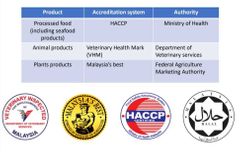
|
|
|
Definition of Zoonoses |
Diseases or infection which is naturally transmissible from animals to humans (OIE, 2002) |
|
|
Types of Zoonoses |
1. Cycloozoonosis - 2 species of vertebrates as definitive and intermediate host to complete life cycle as an agent - eg: JE, Trypanosoma, Bovine Cysticercosis
2. Metazoonosis - transmitted by vertebrates by invertebrates - eg: Trypanosomiasis, Filariasis, Fascioliosis, Trichinellosis
3. Saprozoonosis - requires soil/plants as reservoirs - eg: Fasciolliosis, Erysipelas
4. Antrhopozoonoses - longer/original term for zoonosis - animals to humans - eg: Rabies, Brucellosis, Anthrax
5. Zooanthroponoses - reverse zoonosis (humans to animals) - eg: Amoebiosis, Diphtheriosis
6. Amphixenoses - infections that can be from animals to humans and vice versa - eg: Staphylococcal infection, Streptococcal infection |
|
|
Notifiable Zoonoses by DVS |
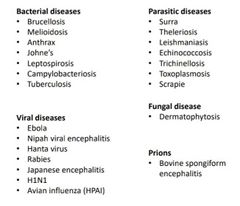
|
|
|
Reservoir vs Carrier |
Reservoir: Harbouur organism in specific organs/tissues & sheds pathogens for a lifetime/intermittently Carrier: A person/animal that harbours a specific infectious agent without discernible clinical disease (asymptomatic) & serves as a potential source of infection |
|
|
Chain of Infection |
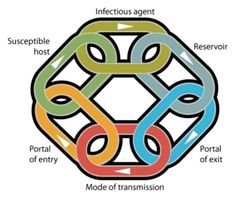
|
|
|
Emerging zoonoses |
A new infection due to evolution or change of an existing pathogen/parasite resulting in a change of host range, vector, pathogenicity or strain.
Eg: SARS, H1N1, H5N1, Nipah virus, Ebola, Zika, Covid, Lepto, Rabies |
|
|
Re-emerging zoonoses |
An already known disease that either shifts its geographical setting or expands its host range or significantly increases its prevalence. |
|
|
Neglected zoonoses |
A zoonotic disease which does not receive much attention. ** occurs in impoverished populations with lack of sanitation, poverty, urban slums, conflict zones |
|
|
Factors of emergence/re-emergence of zoonoses |
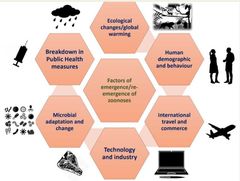
|
|
|
Challenges of overcoming emergence zoonosis |
1. Microbial genetic variations 2. AMR 3. Lack of surveillance 4. Lack proper laboratory tests 5. Lack access to medical facilities |
|
|
Strategies of Emergence Zoonoses Control |
1. Import control 2. Quarantine 3. Control movement 4. Zoning 5. Stray dog management 6. Vaccination 7. Early warning 8. Surveillance 9. Public awareness |
|
|
One Health |
A collaborative, multisectoral and transdisciplinary approach on local, regional, national and global levels to achieve optimal health outcomes and recognizing the interconnection between people, animal, plants and their shared environment. |
|
|
Infectious Disease that are climate sensitive |
1. Dengue 2. Cholera 3. JE 4. West Nile virus |
|
|
Foodborne infection vs Foodborne Intoxification |
Foodborne infection: pathogens invade & multiply in intestinal lining and cause infection within hours to several days, COMMUNICABLE disease Foodborne intoxification: toxins from pathogens causing disease/clinical signs within minutes to hours, absent invasion/multiplication, non-communicable |
|
|
Example of foodborne pathogens |
bacteria 1. Bacillus cereus 2. Campylobacter jejuni 3. Clostridium botulinum (type A, B, E, H in humans) 4. Clostridium perfringens 5. E. coli 6. Listeria monocytogenes 7. Salmonella spp 8. Vibrio spp.
virus 1. Hepatitis A 2. Norovirus
parasite 1. Toxoplasmosis 2. Trichinella spiralis
fungal 1. Aflatoxin 2. Mycotoxin |
|
|
Example of foodborne toxins |
1. Pufferfish - tetrodotoxin 2. Tuna - mercury 3. Sprout potatoes - glycoalkaloids 4. Shellfish - domoic acid (amnestic), okadaic acid (diarrheal), brevetoxins (neurotoxic), saxitoxin (paralytic) |
|
|
Food safety vs Food hygiene |
Food safety - scientific discipline describing handling, preparation and storage of food to prevent foodborne illness Food hygiene - conditions and measures necessary to ensure the safety of food from production to consumption |
|
|
Definition of food safety |
A scientific discipline describing the handling, preparation and storage of food in ways that prevent food-borne illness |
|
|
Key components of Food Safety |
1. Food hygiene 2. Food origin 3. Food labelling 4. Food additives 5. Pesticide residues 6. Import and export guidelines 7. Certification systems for food |
|
|
Codex Alimentarius (Food code by FAO) |
Collection of internation food standards, codes of practice, guidelines, and recommendations to protect consumers' health and ensure fair practices in the food trade. |
|
|
Food Safety Temperatures |
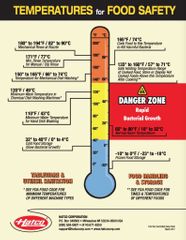
|
|
|
Food Preservation Methods |
1. Heat treatment 2. Low temp (chilling or freezing) 3. Drying (dehydration to reduce water activity) 4. Chemical preservation 5. Vacuum packaging 6. Smoking 7. Irradiation |
|
|
Measures to check contamination on food production |
1. Coliform plate count 2. Standard plate test - Salmonella, E. coli, Yersinia pestis, Klebsiella, Shigella |
|
|
Factors affecting microbial growth on food |
Intrinsic factor 1. Nutrients - proteins, carbs, lipids, water, energy, nitrogen, vitamin, minerals 2. pH - best = 6.8-7.5 3. water activity (Aw) - adequate free water supplements bac 4. Redox potential - High R/O potential = bac thrive Extrinsic factor 1. Temperautre 2. Relative humidity - excessive moisture 3. Gaseous atmosphere - aerobic/anaerobic 4. Time |
|
|
Methods to evaluate effectiveness of Pasteurization of milk to prevent spoilage |
1. Dye reduction test - resazurin, methylene blue, phosphatase 2. Coliform test 3. Salt conductivity test |
|
|
Postmortem meat inspection |
1. Visual appearance - size, shape, color 2. Palpation of organs - texture, stickiness, softness, dryness, wetness 3. Incision of organs |
|
|
Veterinary Certification on Food Safety |
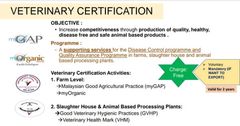
|
|
|
GMP definition |
definition: A set of regulations, codes, and guidelines that controol the operational conditions within a food establishment allowing the production of safe food. |
|
|
GMP elements |
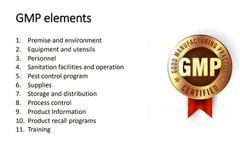
|
|
|
Requirements for HALAL |

|
|
|
Example of Antimicrobial Growth Promoters (AGP) |
1. Avoparcin 2. Spiramycin 3. Bacitracin 4. Avilamycin 5. Flavomycin 6. Tylosin 7. Carbadox 8. Olaquindox |
|
|
Why antibiotics are used as GP? |
1. Nutrient protection 2. Improve nutrient absorption 3. Decrease bacterial toxins production 4. Reduced subclinical infections / disease prevention 5. Increase carcass yield 6. Increase meat quality 7. Increase production |
|
|
Definition of Drug Residue |
Drugs and their metabolites which are found in the edible tissues and milk of animals after their medication with specific drug |
|
|
Definition of extra-label drug |
The use of an approved drug in a manner that is not in accordance with the approved label directions |
|
|
Concerns of veterinary drug residues |
1. Antibiotic resistance 2. Hypersensitivity reactions 3. Mutagenic, carcinogenic and tetragenic risk 4. Disruption of normal intestinal microflora 5. Development of superbugs |
|
|
Factors influencing Veterinary Drug Residue |
1. Disease outbreak 2. Increase meat demand 3. Improper antimicrobial dosage 4. Use of extra-label drug with unknown withdrawal period 5. Non-enforcement laws 6. Low education and expertise of farmers 7. Poor husbandry practice 8. Non-compliance with antimicrobial withdrawal periods 9. Illegal sale of vet prescription drugs 10. Marketing/slaughter of medicated animals 11. Lack of animal identification and traceability system |
|
|
Example of drug resistance bacteria |
1. MRSA 2. VRE 3. Multidrug-resistant M. tuberculosis (MRTB) 4. Carbapenem-resistant Enterobacteriaceae (CRE) 5. Multidrug-resistant Acinetobacter |
|
|
Banned antibiotics for food animals and aquaculture |
1. Avoparcin 2. Chloramphenicol 3. Nitrofurans (nitrofuratoin, nitrofurazone, furazolidone, furaltadone) 4. Teicoplanin 5. Vancomycin 6. Norfloxacin |
|
|
HACCP principles |
1. Identify hazard and preventive measures 2. Identify Critical Control Points (CCP) 3. Establish critical limits 4. Establish CCP monitoring programs 5. Establish corrective actions 6. Establish verification procedures 7. Establish records |
|
|
Advantages of VHM |
1. Food safety assurance 2. Consumer trust 3. Fulfill requirements of local and international market 4. Monitoring by DVS 5. Easy to obtain vet health cert |
|
|
Methods of carcass disposal |
1. Deep burial 2. Incineration 3. Composting 4. Rendering (conver into meat and bone meal) 5. Alkaline hydrolysis (dissolve in Na/K hydroxide) |
|
|
Waste management methods |
1. Manure pit 2. Biological treatment 3. Composting 4. Pool system
alternative 1. Biogas system 2. Biofilter system 3. Effective Microbes (EM) |
|
|
Waste Treatment Pools |
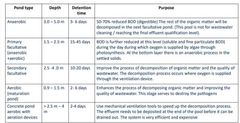
|
|
|
Effects of improper animal waste management |
1. Deterioration of water quality - nitrate pollution 2. Water pollution 3. Soil contamination 4. Heavy metal contamination 5. Air pollution 6. Climate change 8. Deterioriation of human and animal health |

